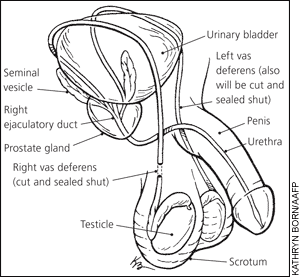
Am Fam Physician. 2006;74(12):2076
See related article on vasectomy.
What is a vasectomy?
A vasectomy (vass-ECK-toe-me) is an operation that stops men from being able to get a woman pregnant. During the surgery, your doctor will permanently seal off tubes called the vas deferens (see drawing). This stops sperm from getting into the semen when you have sex. After the surgery, you won’t be able to get a woman pregnant.

How reliable is vasectomy?
Vasectomy is one of the most reliable ways of preventing pregnancy. Only about one in 300 vasectomies doesn’t work. Your doctor may test your semen after the surgery to make sure that the surgery was successful. It usually takes six to 12 weeks before there are no more sperm in your semen. You should use another form of birth control until your doctor tells you that all of the sperm are gone.
Are there any side effects?
A vasectomy does not stop you from getting an erection or having an orgasm. It doesn’t make you more likely to have prostate cancer or other prostate problems. Some men feel sore for a few months, but this is rare. Your doctor can give you medicine to help with the soreness.
How soon can I start doing my normal activities?
Follow your doctor’s directions before and after the vasectomy. You should plan to rest for one or two days. You can slowly increase your activities during the next week. The incisions should stay dry for 24 hours. After that, you can wash the area gently with water and pat it dry. Usually you can start having sex again after one week. Ask your doctor what is best for you.